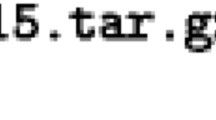Abstract
The Dutch Identity is a useful way to reexpress the basic equations of item response models that relate the manifest probabilities to the item response functions (IRFs) and the latent trait distribution. The identity may be exploited in several ways. For example: (a) to suggest how item response models behave for large numbers of items—they are approximate submodels of second-order loglinear models for 2J tables; (b) to suggest new ways to assess the dimensionality of the latent trait—principle components analysis of matrices composed of second-order interactions from loglinear models; (c) to give insight into the structure of latent class models; and (d) to illuminate the problem of identifying the IRFs and the latent trait distribution from sample data.
Similar content being viewed by others
References
Basawa, I. V., & Rao, B. L. S. P. (1980). Statistical inference for stochastic processes. New York: Academic Press.
Birnbaum, A. (1968). Some latent trait models and their use in inferring an examinee's ability. In F. Lord & M. Novick,Statistical theories of mental test scores (pp. 395–479). Reading, MA: Addison-Wesley.
Bishop, Y., Fienberg, S., & Holland, P. (1975).Discrete multivariate analysis: Theory and practice. Cambridge, MA: MIT Press.
Bock, R. D., & Aitken, M. (1981). Marginal maximum likelihood estimation of item parameters: Application of the EM algorithm.Psychometrika, 46, 443–459.
Bock, R. D., & Lieberman, M. (1970). Fitting a response model for n dichotomously scored items.Psychometrika, 35, 179–197.
Bock, R. D., & Mislevy, R. (1982). Adaptive EAP estimation of ability in a micro-computer environment.Applied Psychological Measurement, 6, 431–444.
Cressie, N. (1982). A useful empirical Bayes identity.Annals of Statistics, 10, 625–629.
Cressie, N., & Holland, P. W. (1983). Characterizing the manifest probabilities of latent trait models.Psychometrika, 48, 129–141.
Dawid, A. P. (1970). On the limiting normality of posterior distributions.Proceedings of the Cambridge Philosophical Society, 67, 625–633.
de Leeuw, J., & Verhelst, N. (1986). Maximum likelihood estimation in generalized Rasch models.Journal of Educational Statistics, 11, 183–196.
Holland, P. (1981). When are item response theory models consistent with observed data?Psychometrika, 46, 79–92.
Holland, P., & Rosenbaum, P. (1986). Conditional association and unidimensionality in monotone latent variable models.Annals of Statistics, 14, 1523–1543.
Kemperman, J. H. B. (1968). “The general moment problem, a geometric approach.”Annals of Mathematical Statistics, 39, 93–122.
Lord, F. (1962). Review of: Studies in Item Analysis and Prediction.Psychometrika, 27, 207–213. (Solomon, H. (Ed). (1961).Studies in item analysis and prediction. Stanford, CA: Stanford University Press.)
Mislevy, R., & Bock, R. D. (1982). BILOG: Item analysis and test scoring with binary logistic models [computer program]. Mooresville, IN: Scientific Software.
Thissen, D., Steinberg, L., & Wainer, H. (1988). Use of item response theory in the study of group differences in trace lines. In H. Wainer & H. Braun (Eds.),Test validity (pp. 147–170). Hillsdale, NJ: Erlbaum.
Tsao, Rhett. (1967). A second order exponential model for multidimensional dichotomous contingency tables with applications in medical diagnosis. Unpublished doctoral thesis, Harvard University, Department of Statistics.
Wingersky, M. (1983). LOGIST: A program for computing maximum likelihood procedures for logistic test models. In R. K. Hambleton (Ed.),Applications of item response theory (pp. 45–56). Vancouver, BC: Educational Research Institute of British Columbia.
Author information
Authors and Affiliations
Additional information
This research was supported in part by contract number N00014-87-K-0730 from the Cognitive Science Program of the Office of Naval Research. I realized the usefulness of the identity in Theorem 1 while lecturing in the Netherlands during October, 1986. Because this was in no small part due to the stimulating psychometric atmosphere there, I call the result the Dutch Identity.
Rights and permissions
About this article
Cite this article
Holland, P.W. The Dutch Identity: A new tool for the study of item response models. Psychometrika 55, 5–18 (1990). https://doi.org/10.1007/BF02294739
Received:
Revised:
Issue Date:
DOI: https://doi.org/10.1007/BF02294739




